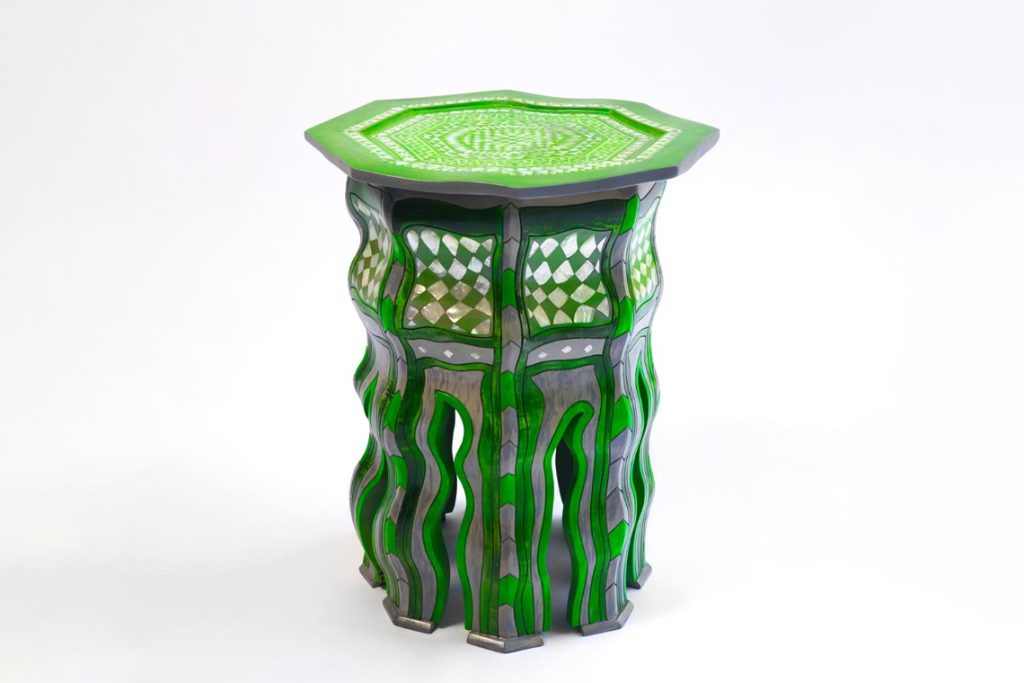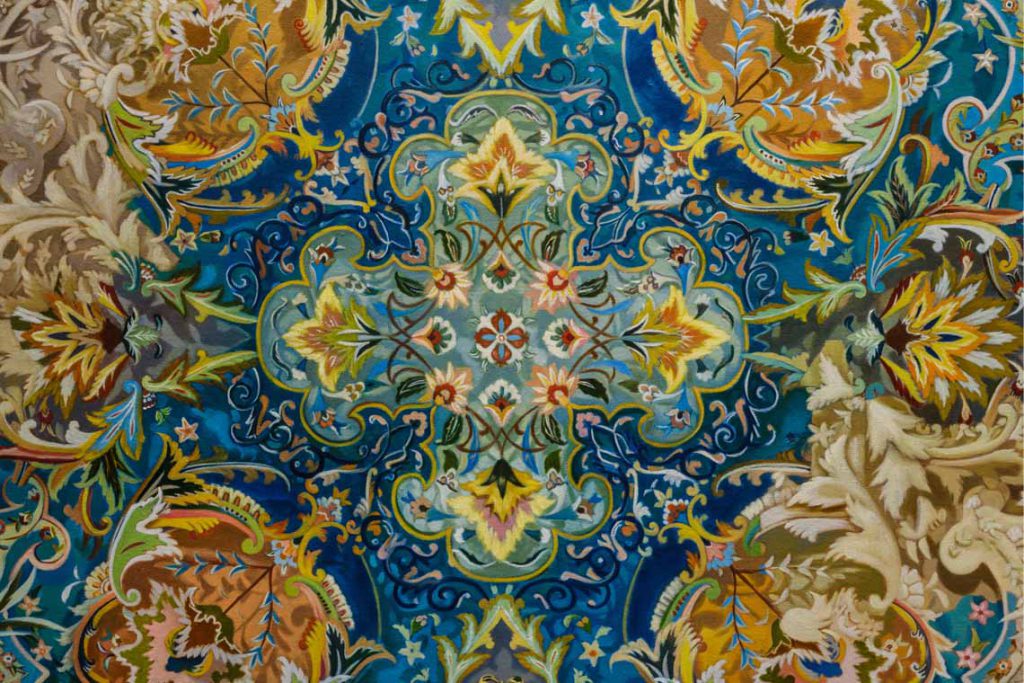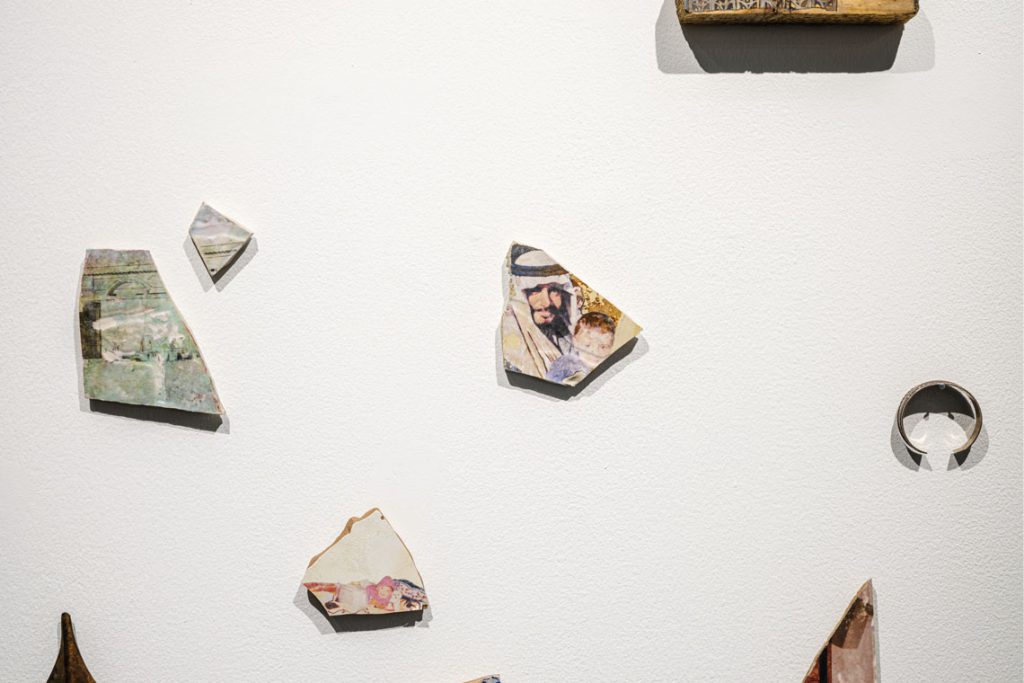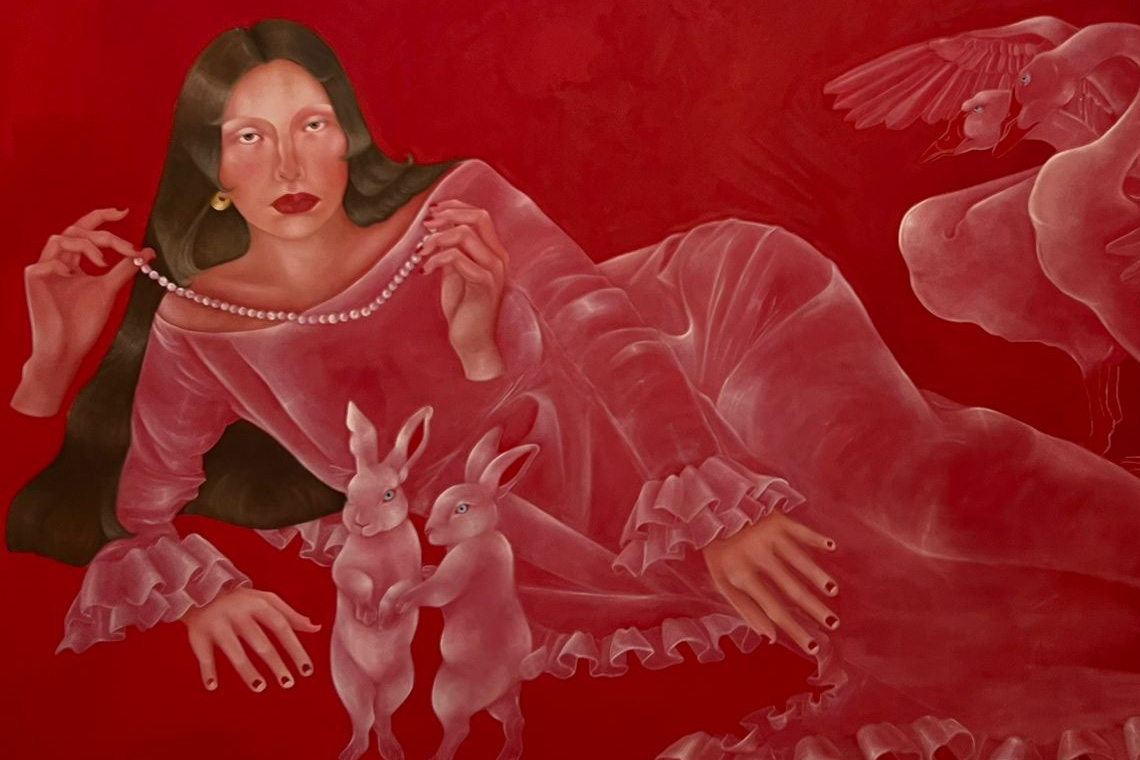The multi-artist exhibition, The Fifth Wife at Firetti Contemporary, charts the transformation of MENA myths under the forces of modernity.
The title of this exhibition, The Fifth Wife, raises pressing questions. Who is the fifth wife? How can there be a fifth wife? In reality, the fifth wife is a creation of the curators’ imagination – a symbolic figure embodying the themes approached by artists from the MENA region in this group presentation at Firetti Contemporary.
The selected artists – Aidha Badr, ARE Studios, Ghaleb Hawila, Jason Seife, Khalid Zahid, Salmah Al-Mansoori, and Sawsan Al Bahar – wrestle with intimate and collective mythologies through their respective media. The Syrian collective, ARE Studio, for instance, intertwine objects with oral storytelling traditions, dissolving the lines between materiality and narrative. Their intricate end tables, HSL and Shift (2024), meld emerald and sapphire-tinged wood with mother of pearl through an approach with its roots in Damascene carpentry tradition. The objects not only form portals to intimate spaces where stories are shared, but also probe the distortion of collective practices over time through the reappropriation of form.

ARE STUDIO. HSL 120 Ed. 2/15, 2024. End table, Wood, Mother of Pearl. 50 cm x 65 cm. Image courtesy of the artist and Firetti Contemporary
ARE Studio’s tables witness cultural traditions succumb to the forces of chaos; clean lines are interrupted with intentional glitches and abstractions. It’s work that invites contemplation on the ways in which traditions are passed from one generation to another, morphing and mutating with the passing of time. The intergenerational exchange of culture has also influenced the Cuban-Syrian artist, Jason Seife. Seife’s oil-on-canvas painting, Bloom (2024), is an elaborately embellished composition that compresses time and space, recasting the geometric motifs of traditional Persian rugs for the present day.
In addition to exploring formal traditions, the exhibition charts more conceptual interpretations of mythologies and folklore. What is interesting in this case is the way that these artists process the psychological effects of their exposure to dominant narratives. For example, the Saudi artist Khalid Zahid disarms stereotypes associated with Islam and the myths imposed on the ‘other’ from the outside. In Simplicity of Islam (2014) he captures a moment of unexpected playfulness: a sheikh, mid-air on a trampoline, frozen in motion through photography. The scene boldly contests the notion of faith as a sombre space.
Adjacent is a second work from Zahid’s repertoire, part of The Women of Islam series (2024). Here, a veiled woman stands before cartons of milk, stacked in a grocery store, raising two densely detailed metal discs. The tension between the domestic setting and the shields, as a symbol of strength, summons the legacy of the courageous women who have played pivotal roles in Islam’s history, portraying them as empowered warriors. This thematic exploration extends into Zahid’s Yusur series (2019), where he invites us to reimagine mosques not as stoic structures, but as child-like, baby blue balloons floating in the air.

Within other works, more intimate narratives unfold. Two pieces on the back wall by the Egyptian artist Aidha Badr initially seem disparate, yet upon closer inspection, reveal a shared thread of maternal lineage and memory. In Please forgive me for what I do when I don’t remember you I and II (2024), Badr considers the complexities of the mother-daughter relationship, connecting the notion of mythologies with familial bonds. Her crimson-hued oil-on-canvas painting is invested with a near-translucent quality, evoking the possibility of forgetting. Casting a critical gaze towards the passage of tradition and gendered identity across generations, the work exemplifies the transfer of heirlooms from mother to daughter through the lifting of a string of pearls, from the mother’s neck towards her daughter.
In the accompanying textile piece, the phrase “Please forgive me for what I do when I don’t remember you” is stitched in an arresting shade of red across a base of fragile, tulle table linen. Here, the transference of tangible remnants down through generations of women in Badr’s family is negotiated through the tablecloth. It is work that captures cultural conventions concerning femininity and the inevitable transformation of identity over time. As the daughter inherits these linens upon marriage, she undergoes a metamorphosis.
Another artist grappling with themes of memory and identity is Emirati multimedia artist Salmah Almansoori. Her installation Who I Became (2024) comprises fragments of shattered ceramics adorned with family portraits, perfume jars and other mementos scattered across the wall. These objects, seemimgly lifted from a family home, reflect Almansoori’s belief that a physical space absorbs memories and shapes the self, mirroring the concept of oral culture preserving heritage. By transferring photographs onto tiles collected from spaces she has inhabited, the artist imbues these objects with the weight of time and associated memories, much in the way that folkloric tales might carry the weight of generations.

Copyright The Artist
Amidst growing disillusionment with current realities, there has been a notable emergence of artists seeking refuge in mysticism and mythologies on a global scale. The Fifth Wife exemplifies this within the MENA context. Some artists embark on a journey of temporal translation, drawing the past into the present, while others contemplate the mechanisms through which memories and societal norms undergo reinforcement and reconfiguration. This consideration of customs, stereotypes and storytelling traditions, approached through a spectrum of perspectives, attests to the complexities and ongoing transformation of MENA identities. What is particularly intriguing here is the intergenerational dialogue, where one generation reflects on and connects to or critiques the practices of another, highlighting not only the enduring significance of tradition in contemporary times but also the manner in which individuals filter it through their own lived experiences, thereby making it uniquely their own.



